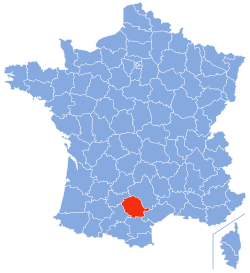Tarn (department)
Tarn | |
|---|---|
 The old city of Albi and the Tarn river | |
 Location of Tarn in France | |
| Country | France |
| Region | Languedoc-Roussillon-Midi-Pyrénées |
| Departement | Since 4 March 1790 |
| Prefecture | Albi |
| Subprefecture | Castres |
| Government | |
| • President of the General Council | Thierry Carcenac |
| Area | |
• Total | 5,757.9 km2 (2,223.1 sq mi) |
| Population (2013)[2] | |
• Total | 381,927 |
| • Rank | 62 |
| • Density | 66/km2 (170/sq mi) |
| Demonym | Tarnais |
| Time zone | UTC+1 (CET) |
| • Summer (DST) | UTC+2 (CEST) |
| ISO 3166 code | FR-81 |
| Arrondissements | 2 |
| Cantons | 23 |
| Communes | 320 |
| Website | http://www.tarn.fr |
Tarn (French pronunciation: [ta:ʁ] or French pronunciation: [taʁn]; Template:Lang-oc) is a French department located in the Languedoc-Roussillon-Midi-Pyrénées region in the southwest of France named after the Tarn river. Its prefecture and largest city is Albi.
The inhabitants of Tarn are known, in French, as Tarnais (women: Tarnaises).[3]
History
Tarn is one of the original 83 departments created during the French Revolution on 4 March 1790, through application of the Law of 22 December 1789. It was created from part of the former province of Languedoc, and comprised the dioceses of Albi and Castres (which found themselves merged in 1817).
The new department had five districts: Albi, Castres, Lavaur, Gaillac, Lacaune. The capitals (now prefectures) were, alternatively, Albi and Castres but, from 1790 to 1797, the capital was only Albi; in 1797, the capital was moved to Castres.[4]
In 1800, Albi became again the capital of the department and the arrondissements were created; the department had four arrondissements: Albi, Castres, Gaillac and Lavaur. In 1926, the arrondissements of Gaillac and Lavaur were eliminated.[4]
By the law of 28 Pluviôse Year 5, the departments of Hérault and of Tarn exchanged the canton of Anglès (which had been part of the diocese of Saint-Pons, but which has remained in Tarn) for that of Saint-Gervais-sur-Mare (which had been part of the diocese of Castres, but which today remains in Hérault).
Geography
Tarn is part of the Languedoc-Roussillon-Midi-Pyrénées region and has an area of 5,757.9 km2 (2,223 sq mi).[1]
The department is surrounded by 5 departments, all belonging to the region Languedoc-Roussillon-Midi-Pyrénées:
- Hérault (southeast)
- Aude (south)
- Aveyron (north and east)
- Haute-Garonne (southwest and west)
- Tarn-et-Garonne (northwest)
The slope of the department is from east to west, and its general character is mountainous or hilly.

Tarn's three principal ranges lying to the south-east are: the Mountains of Lacaune, the Sidobre, and the Montagne Noire, belonging to the Cevennes.
The stony and wind-blown slopes of the Mountains of Lacaune (Monts de Lacaune) are used for pasture. The highest point of the range and of the department is the Puech Montgrand, 1,267 m (4,157 ft) high; several other summits are not much short of this.
The granite-strewn plateaux of the Sidobre, from 490 to 610 m (1,600 to 2,000 ft) high, separate the valley of the river Agout from that of its western tributary, the river Thoré.
The Montagne Noire, on the southwestern border of the department, derives its name from the forests on its northern slope. Its highest point is the Pic de Nore at 1,211 m (3,973 ft) high.
The limestone and sandstone foot-hills are clothed with vines and fruit trees, and are broken by deep alluvial valleys of particular fertility. With the exception of a small portion of the Montagne Noire, which drains into the river Aude, the whole department belongs to the basin of the Garonne.
Administration
Tarn is part of the region of Languedoc-Roussillon-Midi-Pyrénées and is managed by the General Council of the Tarn in Albi.
Administrative divisions
There are 2 arrondissements, 23 cantons and 323 communes in Tarn.
| Arrondissement | INSEE code | Capital | Population[5] (2012) |
Area (km²) |
Density (Inh./km²) |
Communes |
|---|---|---|---|---|---|---|
| Albi | 811 | Albi | 186,515 | 2,732 | 68.3 | 170 |
| Castres | 812 | Castres | 192,432 | 3,026 | 63.6 | 153 |
Demographics
Tarn has a population, in 2012, of 378,947,[2] for a population density of 65.8 inhabitants/km2. The arrondissement of Castres, with 192,432 inhabitants, is the arrondissement with more inhabitants. The arrondissement of Albi has 186,515 inhabitants.[5]
The 10 largest cities, with more than 6,000 inhabitants, in the department are:

| City | Population (2012)[5] |
Arrondissement |
|---|---|---|
| Albi | 49,231 | Albi |
| Castres | 41,529 | Castres |
| Gaillac | 13,820 | Albi |
| Graulhet | 11,890 | Castres |
| Lavaur | 10,242 | Castres |
| Mazamet | 10,093 | Castres |
| Saint-Sulpice | 8,327 | Castres |
| Saint-Juéry | 6,715 | Albi |
| Labruguière | 6,365 | Castres |
| Aussillon | 6,167 | Castres |
Gallery
-
Castres theatre
See also
- Cantons of the Tarn department
- Communes of the Tarn department
- Arrondissements of the Tarn department
- Tourism in Tarn
References
- ^ a b "Département du Tarn (81) - Résumé statistique". Publications et statistiques pour la France ou les régions (in French). Institut national de la statistique et des études économiques - INSEE. Retrieved 8 August 2015.
- ^ a b "Populations légales 2012 des départements et des collectivités d'outre-mer" (in French). Institut national de la statistique et des études économiques - INSEE. Retrieved 8 August 2015.
- ^ "Tarn (81)" (in French). habitants.fr. Retrieved 8 August 2015.
- ^ a b "Historique du Tarn". Le SPLAF (in French). Retrieved 8 August 2015.
- ^ a b c "Populations lègales 2012 - 81-Tarn". Populations légales 2012 des départements et des collectivités d'outre-mer (in French). Institut national de la statistique et des études économiques - INSEE. Retrieved 8 August 2015.






